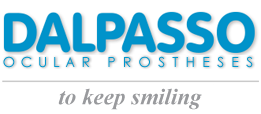Prostheses can be worn throughout the whole day, including the nighttime – except for sub-atrophic eye shells that should be removed before going to sleep. They do not limit everyday life activities, since patients can drive, wear makeup, and practice both traditional and underwater sports.
However, there are some changes and drawbacks that you have to bear in mind:
during the first days of monocular vision, you will experience some troubles perceiving the correct position of the objects placed in front of you – for instance, you will not be able to catch a glass on a table on your first attempt. This phenomenon is due to the lack of stereoscopic vision and the subsequent loss of depth of field. This situation can last from a few days to a few weeks, and tends to disappear automatically as the new visual information reaches your brain and gets processed by it.
The lack of one eye will force you to make head movements towards the corresponding blind area, in order to compensate the loss of both distance perception and visual field. As an example, you will find yourself compelled to move your head towards the door or the rear mirror while driving a car.
After an enucleation surgery, sometimes lacrimation may decrease and consequently reduce both the socket and the prosthesis lubrication. In less serious cases, you can obviate the problem by using eye drops or artificial tears – available in drops or gel; in more serious cases, if the dysfunction tends to become chronic, we recommend you to have a more thorough eye examination.
Prostheses usually stimulate the abundant secretion of the eye socket. If your socket keeps on secreting despite the removal of the prosthesis and the subsequent cleaning of both the prosthesis and the socket – as shown by these videos, we recommend you to have a more thorough eye examination.








